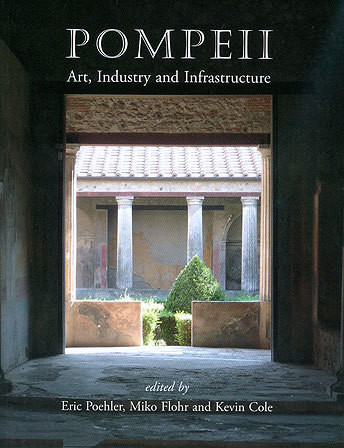
Format: Paperback
Pages: 200
ISBN: 9781842179840
Pub Date: 15 Apr 2011
Illustrations: 99 illus
Description:
Even after more than 250 years since its discovery, Pompeii continues to resonate powerfully in both academic discourse and the popular imagination. This volume brings together a collection of ten papers that advance, challenge and revise the present conceptions of the city's art, industry and infrastructure. The discussions of domestic art in this book, a perennial topic for Pompeian scholars, engage previously neglected subjects such as wall ornaments in domestic decoration, the sculpture collection in the house of Octavius Quartio, and the role of the covered walkways in luxury villa architecture.
The famous cupid's frieze from the house of the Vettii is given a novel and intelligent reinterpretation. The place of industry at Pompeii, in both the physical and economic landscapes has long been overlooked. The chapters on building practice in inhabited houses, on the presence of fulling workshops in atrium houses, and on the urban pottery industry serve as successful contributions to a more complete understanding of the life of the ancient city. Finally, this volume breaks new ground in the consideration of the urban infrastructure of Pompeii, a topic that has won serious attention only in the last decades, but one that is playing an increasingly central role in Pompeian studies. The final three chapters offer a reassessment of the Pompeian street network, a scientific analysis of the amount of lead in Pompeian drinking water, and a thorough analysis of the water infrastructure around the forum that supported its architectural transformation in the last decades before the eruption of mount Vesuvius in AD 79.

Format: Paperback
Pages: 160
ISBN: 9781842174524
Pub Date: 15 Apr 2011
Series: TRAC
Illustrations: b/w illus
Description:
This volume contains ten papers reflecting current aspects of the debate in theoretical Roman archaeology. They include papers on what the pottery finds from the Nepi Survey Project can tell us about how the local landscape was used and inhabited, poliadic deities in Roman colonies in Italy, Pompeii, the practice of the recycling of architectural materials and personal adornment concerning textile remains and brooches.

Format: Paperback
Pages: 208
ISBN: 9781842173763
Pub Date: 31 Mar 2011
Series: Studies in Funerary Archaeology
Illustrations: 79 b/w illustrations and maps
Description:
This volume investigates the archaeology of death and commemoration through thematically linked case studies drawn from the Classical world. These investigations stress the processes of burial and commemoration as inherently social and designed for an audience, and they explore the meaning and importance attached to preserving memory. While previous investigations of Greek and Roman death and burial have tended to concentrate on period- or regionally-specific sets of data, this volume instead focuses on a series of topical connections that highlight important facets of death and commemoration significant to the larger Classical world.
Living through the dead investigates the subject of death and commemoration from a diverse set of archaeologically informed approaches, including visual reception, detailed analysis of excavated remains, landscape, and post-classical reflections and draws on artefactual, documentary and pictorial evidence. The nine papers present recent research by some of the leading voices on the subject, as well as some fresh perspectives. Case studies come from Thermopylae, the Bosporan kingdom, Athens, Republican Rome, Pompeii and Egypt. As a collected volume, they provide thematically linked investigations of key issues in ritual, memory and (self)presentation associated with death and burial in the Classical period. As such, this volume will be of particular interest to postgraduate students and academics with specialist interests in the archaeology of the Classical world and also more broadly, as a source of comparative material, to people working on issues related to the archaeology of death and commemoration.
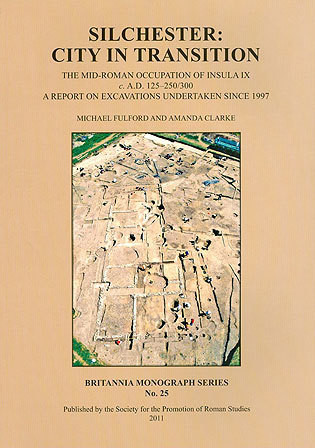
Format: Paperback
Pages: 544
ISBN: 9780907764373
Pub Date: 15 Mar 2011
Series: Britannia Monographs
Description:
Characterising urban life, City in Transition is the second volume reporting on the archaeology of the continuing excavation of Silchester Insula IX, taking the story down to the early 2nd century. In describing the evidence for the occupation of the 2nd and 3rd centuries it follows on from Life and Labour in Late Roman Silchester (2006), which published the late Roman occupation. Geochemical and micromorphological analyses inform the interpretation of the use of space within buildings and, together with the study of an abundant material culture and environmental record, provide a rich characterisation of the houses and their occupants.
The report sheds important light on the urban condition, debating such themes as population density, status, occupation, diet and domestic ritual.

Format: Paperback
Pages: 104
ISBN: 9781842174173
Pub Date: 14 Mar 2011
Description:
This volume examines conceptions, ideas and habits connected with children in Antiquity and the Middle Ages, focusing on the "dark sides of childhood" in the pre-modern world. The authors investigate the long-term attitudes of people, as well as ruptures in habits and customs. The book is divided into three parts.
"Unwanted" deals with parents who were unable to bring up their baby and handed it over to other people or the cruel whims of destiny. "Disabled" addresses what we would label as children's illnesses since disability was a concept largely unknown to ancient people. "Nearly Lost" examines demons, viewed as destructive forces with the ability to destroy children or young people, sometimes by literally sucking their lives away. The articles are written by an international team of specialists from Belgium, Finland, Italy and the United States and were presented at conferences organised by the research project "Religion and Childhood. Socialisation from the Roman Empire to Christian World", funded by the Academy of Finland (2009-2012, directed by Dr. Katariina Mustakallio), at the University of Tampere, Finland.

Format: Paperback
Pages: 144
ISBN: 9781842179901
Pub Date: 28 Feb 2011
Illustrations: 13 b/w figs
Description:
This book explores the themes of memory and mourning from the Roman deathbed to the Roman cemetery, drawing subject matter from the literature, art, and archaeology of ancient Rome. It brings together scholarship on varied aspects of Roman death, investigating connections between ancient poetry, history and oratory and placing these alongside archaeological and textual evidence for Roman funerary and commemorative rituals. A series of case studies centred on individual authors and/or specific aspects of ritual behaviour, traces the story of Roman death: how the inhabitants of the Roman world confronted their mortality, disposed of the dead, remembered the dead and praised the dead, thereby enhancing our understanding of Roman society.
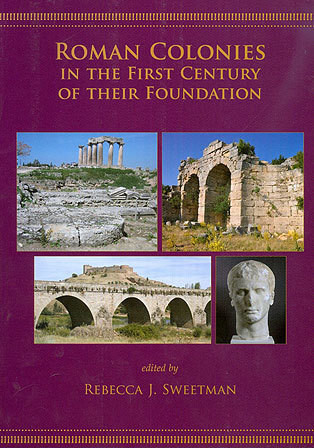
Format: Paperback
Pages: 128
ISBN: 9781842179741
Pub Date: 28 Feb 2011
Description:
Research on the nature of cultural change in the Roman Empire has traditionally been divided between the Western and Eastern provinces. Papers in this volume aim to reunite the provinces by approaching the question of cultural change across the Empire through a range of material culture and historical sources focusing on the first 100 years of the foundation of a colony.

Format: Paperback
Pages: 176
ISBN: 9781842179871
Pub Date: 15 Feb 2011
Illustrations: b/w illus
Description:
Understanding the calendars used by ancient and medieval cultures is essential to the writing of history. Equally important, however, is understanding the basis upon which our current knowledge of these calendars rests. This second volume of Calendars and Years explores the calendars of ancient and medieval China, India, the ancient Jewish world, the medieval Islamic world, and the Maya.
Particular attention is given to the preserved evidence on which our understanding of these calendars lie, the modern historiography of their study, and the role of calendars in ancient and medieval society. Topics covered include the origin of the Chinese sexagenary cycle, evidence for the 364-day year in the ancient Jewish world, and the history of attempts to establish a correlation between Mayan dates and the Julian and Gregorian calendars. 176p, b/w illus (Oxbow Books 2011) Praise for Volume I: "Steele has assembled an essential foundation for the further study of calendariography and chronography in the ancient Near East and Egypt." Francesca Rochberg Journal for the History of Astronomy (November 2008) "It is a book from which there are absolute nuggets of incredible information to be mined." Peter A Clayton

Format: Paperback
Pages: 225
ISBN: 9780956305428
Pub Date: 20 Jan 2011
Imprint: Pre-Construct Archaeology
Description:
Excavations in 2002 by Pre-Construct Archaeology on two adjacent sites in Shadwell revealed an extensive late Romano-British settlement over a kilometre beyond the walls of Londinium on an escarpment overlooking the north bank of the Thames. The area's importance became apparent in the 1970s through the discovery of monumental masonry and 3rd-century settlement and burial practice. This volume presents the evidence for Roman Shadwell as revealed by these excavations and considers its place within the broader context of Londinium and its hinterland.
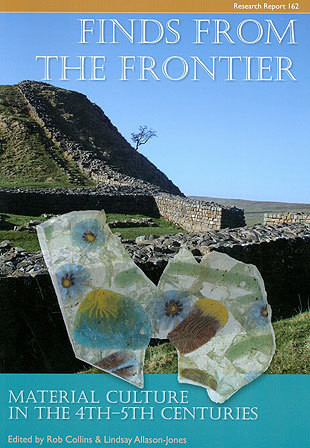
Format: Paperback
Pages: 161
ISBN: 9781902771816
Pub Date: 31 Dec 2010
Illustrations: b/w and col illus
Description:
Finds from the Frontier brings together papers given at a conference held at Newcastle upon Tyne in 2008. Its aim is to elucidate the life of the 4th-century limitanei of Britain through their material culture. The papers consider whether the excavated artefacts justify the traditional implication that the period is one of declining standards and largely come to the conclusion that, on the contrary, the period was rich in artefacts that have much to tell us about the late frontier.
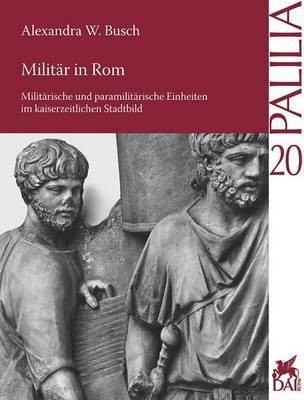
Format: Paperback
Pages: 148
ISBN: 9783895007064
Pub Date: 31 Dec 2010
Imprint: Reichert Verlag
Series: Palilia
Description:
During the Republican era, Rome was considered a demilitarized zone. Augustus's rule marked the first time soldiers were stationed in the capital of the Empire and it is therefore a crucial turning point between Republic and Principate. 10,000 to 40,000 soldiers now lived in Imperial Rome and they became an essential part of urban culture.
The theme of this book is the urban Roman army in all its facets; it covers the complexities of its cultural appearance, its effect on the urban population, and the importance of civilian life in the capital. For the first time the written, archaeological and visual sources on the military in Rome are put together and present a comprehensive picture of the life and work of urban Roman soldiers. German Text.
Rómverjasaga
Format: Paperback
Pages: 630
ISBN: 9789979654117
Pub Date: 31 Dec 2010
Imprint: University of Iceland Press
Description:
This is one of the oldest preserved sagas in Icelandic and is compiled from Latin sources, mainly Bellum lugurthinum and Coniutario Catilinae by Sallustius and Pharsalia by Lucanus. The first section is on the Jugurthine wars and then Catilina and his gathering of men. In the later section, the conflict between Pompey and Julius Caesar is depicted.
There are two versions of this saga that have been preserved. In this book, both of them are published letter by letter in compliance with the original text, supported by original Latin texts. The detailed introduction describes the main characteristics of the translation and all the manuscripts in the saga. Icelandic text.

Format: Hardback
Pages: 641
ISBN: 9781900971102
Pub Date: 31 Dec 2010
Imprint: Society for Libyan Studies
Series: Society for Libyan Studies Monograph
Description:
The Archaeology of Fazzan is a major series of reports on the archaeology and history of Libya’s south-west desert region.This volume contains reports and analysis on a series of excavations carried out between 1958 and 1977 by the British archaeologist Charles Daniels, lavishly illustrated by site plans and numerous colour photographs – particularly of the rich artefact assemblages recovered. The publication will be high profile and a significant landmark in work seeking to record information about Libya’s long-term Saharan heritage.
It will be an indispensable reference work to the nature of the Libya’s Saharan archaeology. The work will be of major value to the Libyan antiquities service and contracted archaeologists in concert with foreign oil companies, the NOC and the GMMR, and other similar major schemes.The key element of the story of Fazzan is the existence here of an early Libyan civilisation, the Garamantes, and the publication of the Archaeology of Fazzan volumes is putting in the public domain a rich dossier of information about their antecedents and descendants in this desert environment. This was a singularly important moment in Libya’s cultural history, with resonances also in Sub-Saharan Africa. There is great interest in the published volumes from specialists in Saharan, Sub-Saharan and Mediterranean archaeologists and historians as for the first time we can see in detail the effect of early Trans-Saharan links.
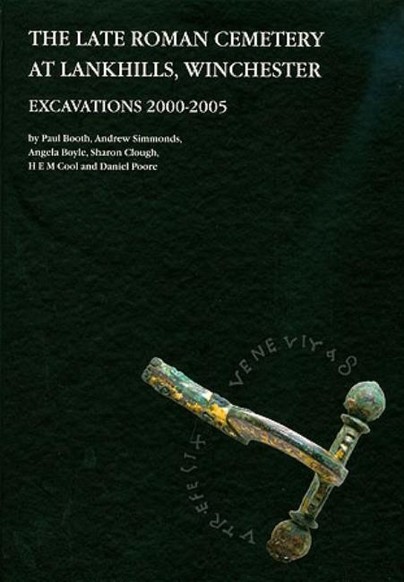
Format: Hardback
Pages: 569
ISBN: 9780904220629
Pub Date: 01 Dec 2010
Description:
Lankhills and its late Roman cemetery have played a significant role in the understanding of the military in civilian areas of Roman Britain in the fourth century, and these new excavations double the number of graves explored and add to the variety of finds represented. New analytical techiques show that some of those buried were immigrants from other parts of Europe and perhaps even North Africa. The new excavations revealed a further 307 inhumation graves (plus six more partly excavated previously) and 25 more cremation burials.
The most spectacular individual burial contained a gilded and inscribed crossbow brooch, silver gilt belt fitting and decorated spurs, a unique assemblage for Roman Britain. The report provides a full catalogue of the graves and a comprehensive study of the finds.

Format: Hardback
Pages: 168
ISBN: 9780714122632
Pub Date: 11 Nov 2010
Series: Corpus Vasorum Antiquorum
Description:
The British Museum's holding of Greek Geometric pottery comprises 200 items, covering the period from the 10th to the 7th century BC. Most of these pieces have never been published before. The bulk of the collection - 123 pieces - is Attic, but eleven other regional styles are also represented.
These include not only mainland Greek fabrics such as Argive, Boeotian, Corinthian and Laconian, but also the island fabrics of the Cyclades and Crete, as well as those of East Greece and Caria. The collection is particularly strong in Melian and Rhodian styles. A brief overview of each style precedes the detailed descriptions of the pieces, so that the book serves not only as a catalogue but also as an introduction to the major local fabrics of Early Iron Age Greece. Every piece is illustrated, many with multiple views and some with additional line drawings. This catalogue is British Museum Fascicule 11 in the Great Britain series of the international Corpus Vasorum Antiquorum.

Format: Hardback
Pages: 480
ISBN: 9780854312948
Pub Date: 11 Nov 2010
Illustrations: c.500 b/w & col photographs and line drawings
Description:
This volume brings to a triumphant conclusion this monumental project to catalogue, describe and illustrate every Romano-British mosaic. The area covered by the fourth and final volume in the corpus is one of the richest regions of Britain in economic as well as architectural and artistic terms and this is reflected in the quantity and quality of the region's mosaics, which include the largest figured mosaic ever found in Britain - the Woodchester Orpheus pavement - which was perhaps the inspiration for the other famous Orpheus mosaics of the Roman Cotswolds. At the heart of this affluent region is Cirencester, Roman Britain's second largest town, represented here by more than sixty mosaics, the second-century examples being the most exquisite in the country.
There are also many fine mosaics from the region's highly ornate villas, as well as from the towns of Gloucester, Caerwent and Wroxeter. The catalogue follows the format of earlier volumes in providing an account of each mosaic's discovery and locating the mosaic within its building plan. Following the description are notable parallels and major references. Many of the illustrations are by the authors, with additional ones by Luigi Thompson, as well as photographs and historical engravings, a high proportion of the latter by Samuel Lysons whose home was in Gloucestershire where he did much of his pioneering work in archaeological excavation and illustration. Brief biographies of Lysons and all the other artists whose work grace all four volumes appear at the end of this volume. As with previous volume the work is preceded with a substantial introduction. This deals with the history and topography of the region, buildings and rooms, an assessment of regional workshops, and schemes, ending with a consideration of mosaics in relation to the end of Roman Britain.















